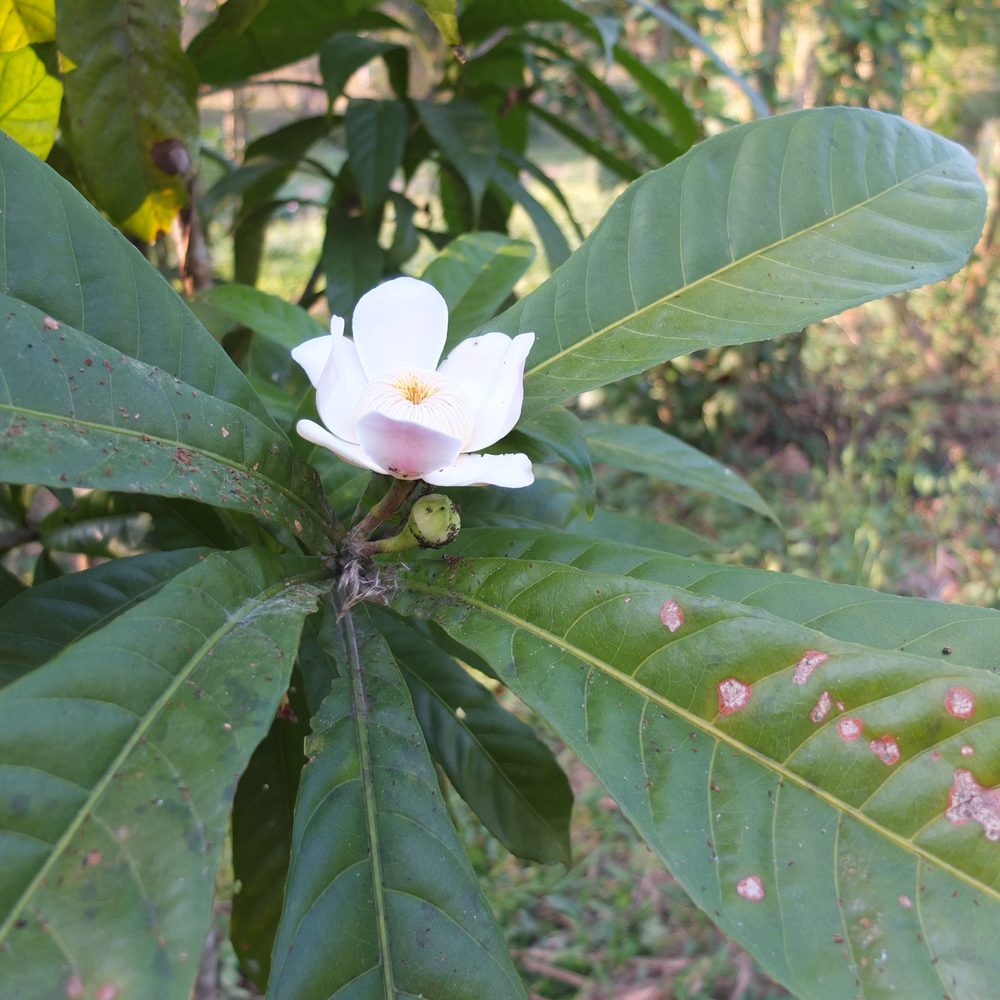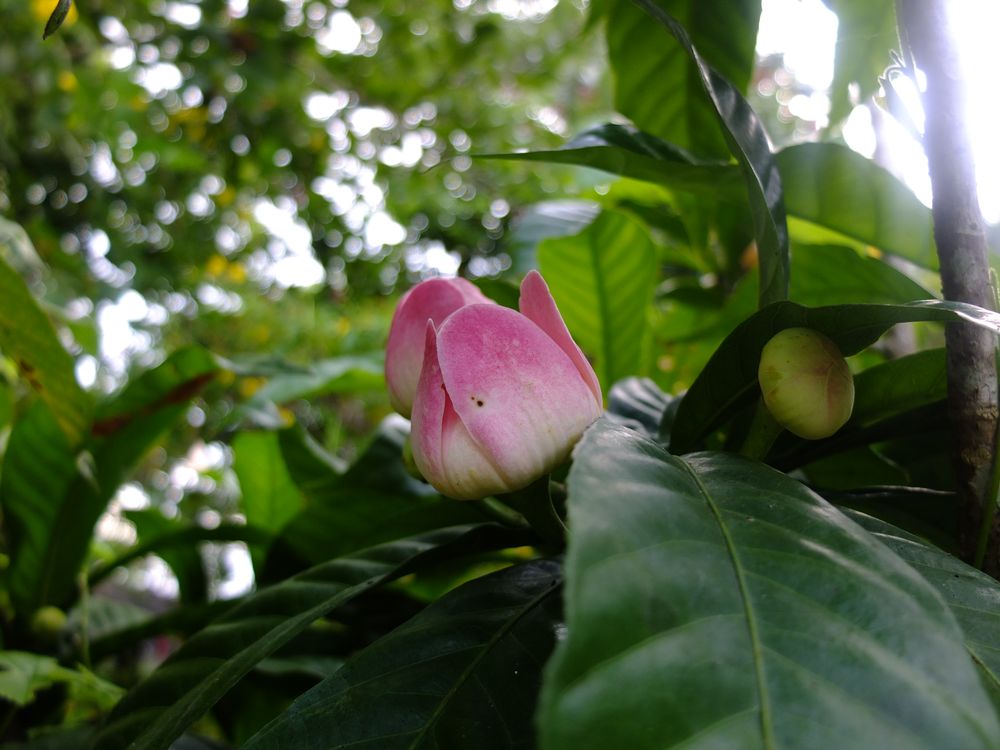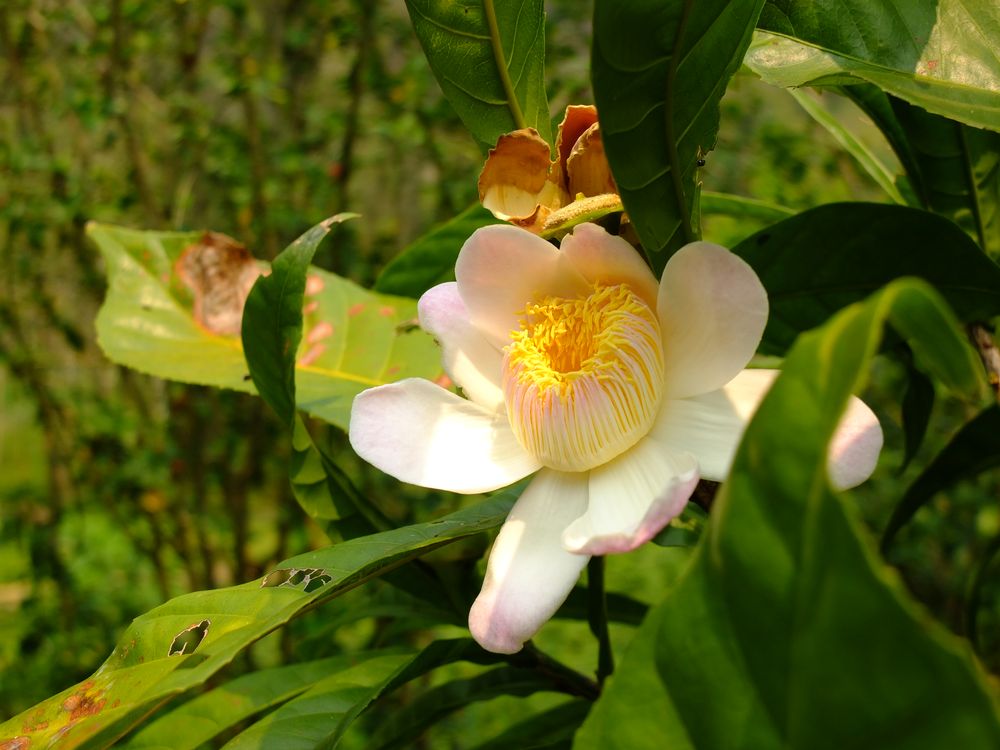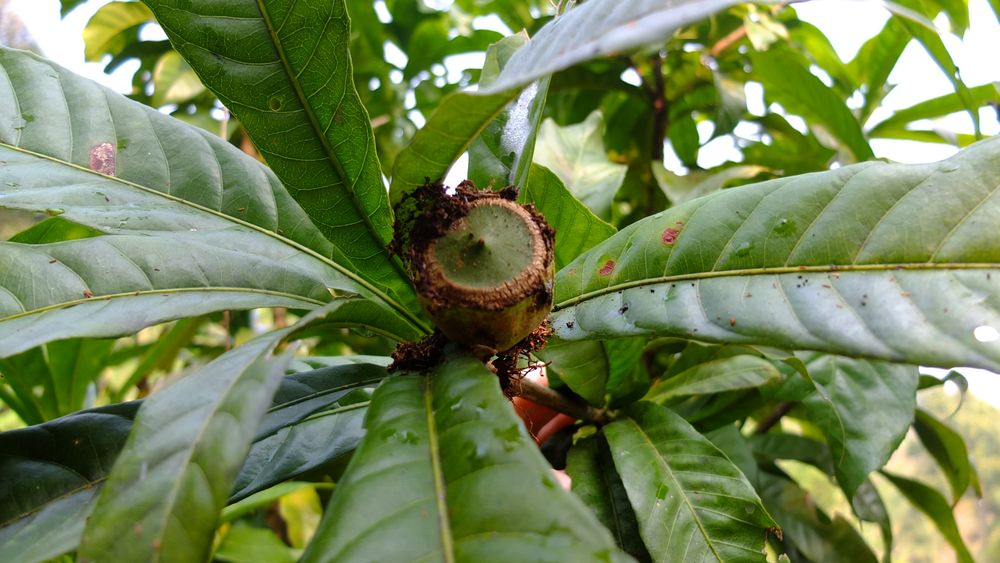Its flower looks like a lotus, but like a lotus that would grow on a tree, that would grow near the sky, near paradise! This sumptuous tropical species is not well known outside its natural range from Ecuador to Panama and Venezuela, but it has been planted in tropical botanical gardens and in several Southeast Asian countries, Singapore, Thailand and now Laos.
It is a medium–sized tree with a straight trunk with tufts of rosette leaves at the ends of the branches; they are large, lance–shaped, rigid, dark green, strongly veined. Between March and June, large regular flowers of around fifteen centimeters bloom which stand out against the green foliage, at the end of the branch or on the main cauliflory branches; they have between 7 and 9 waxy petals, white on the inside, pink on the outside, spotted with yellow at their base; the petals surround a thick crown of creamy white stamens curving towards the yellow center. The fruit is round at the base with a truncated flat surface surrounded by a ring at the top; the interior of the hard shell contains several large seeds in a yellow–orange pulp.
This truly tropical–looking tree was named Gustavia to honor the Swedish king Gustavus III who had supported Linnaeus in his work and who was tragically murdered during a masked ball; everything therefore combines to make this flower a truly unusual plant. However, a caveat must be brought to our description: the wood of this Gustavia smells very bad to the point that in certain American languages it is called “corpse flower”!
In its region of origin, the pulp of the fruit is eaten after cooking and is said to have a meaty taste. Furthermore, birds and monkeys feast on it and bees make very good honey from its flowers. Finally, Native Americans make a decoction with the leaves which can save a wounded person hit by a poisoned arrow.
In Lao we use the Thai name, boua savane, “lotus of paradise” and we can hope that this beautiful tree will be planted a little more often in gardens; you have to take advantage of it, not only is it beautiful, but it grows quickly and well.
Sa fleur ressemble à un lotus, mais à un lotus qui pousserait sur un arbre, qui pousserait près du ciel, près du paradis! Cette somptueuse espèce tropicale n’est pas très connue en dehors de son aire de répartition naturelle de l’Équateur au Panama et au Venezuela, mais il a été planté dans les jardins botaniques tropicaux et dans plusieurs pays d’Asie du Sud-Est, Singapour, Thaïlande et maintenant Laos.
C’est un arbre de taille moyenne au tronc droit avec en bout de branches des touffes de feuilles en rosette; elles sont grandes, en forme de lance, rigides, vert foncé, fortement veinées. Entre mars et juin s’épanouissent de grandes fleurs régulières d’une quinzaine de centimètres qui se détachent sur le feuillage vert, en bout de branche ou sur les rameaux principaux en cauliflorie; elles ont entre 7 et 9 pétales cireux, blancs sur la face intérieure, roses à l’extérieur, tachés de jaune à leur base; les pétales entourent une couronne épaisse d’étamines d’un blanc crémeux recourbées vers le cœur jaune. Le fruit est rond à la base avec au sommet une surface plane tronquée entourée d’un anneau; l’intérieur de la coque dure contient plusieurs grosses graines dans une pulpe jaune-orange.
Cet arbre à l’allure vraiment tropicale a été nommé Gustavia pour honorer le roi de Suède Gustave III qui avait soutenu Linné dans ses travaux et qui est mort tragiquement assassiné lors d’un bal masqué; tout concourt donc à faire de cette fleur une plante vraiment hors du commun. Un bémol doit cependant être apporté à notre description: le bois de ce Gustavia sent très mauvais au point que dans certaines langues américaines il est nommé « fleur de cadavre » !
Dans sa région d’origine la pulpe du fruit est mangée après cuisson et aurait, paraît-il, un goût de viande. Par ailleurs les oiseaux et les singes s’en régalent et les abeilles font un très bon miel de ses fleurs. Enfin, les Amérindiens font avec les feuilles une décoction qui peut sauver un blessé touché par une flèche empoisonnée.
En lao on reprend le nom thaï, boua savane, « lotus du paradis » et l’on peut espérer que ce bel arbre sera planté un peu plus souvent dans les jardins; il faut en profiter, non seulement il est beau, mais encore il pousse vite et bien.




Its flower looks like a lotus, but like a lotus that would grow on a tree, that would grow near the sky, near paradise! This sumptuous tropical species is not well known outside its natural range from Ecuador to Panama and Venezuela, but it has been planted in tropical botanical gardens and in several Southeast Asian countries, Singapore, Thailand and now Laos.
It is a medium–sized tree with a straight trunk with tufts of rosette leaves at the ends of the branches; they are large, lance–shaped, rigid, dark green, strongly veined. Between March and June, large regular flowers of around fifteen centimeters bloom which stand out against the green foliage, at the end of the branch or on the main cauliflory branches; they have between 7 and 9 waxy petals, white on the inside, pink on the outside, spotted with yellow at their base; the petals surround a thick crown of creamy white stamens curving towards the yellow center. The fruit is round at the base with a truncated flat surface surrounded by a ring at the top; the interior of the hard shell contains several large seeds in a yellow–orange pulp.
This truly tropical–looking tree was named Gustavia to honor the Swedish king Gustavus III who had supported Linnaeus in his work and who was tragically murdered during a masked ball; everything therefore combines to make this flower a truly unusual plant. However, a caveat must be brought to our description: the wood of this Gustavia smells very bad to the point that in certain American languages it is called “corpse flower”!
In its region of origin, the pulp of the fruit is eaten after cooking and is said to have a meaty taste. Furthermore, birds and monkeys feast on it and bees make very good honey from its flowers. Finally, Native Americans make a decoction with the leaves which can save a wounded person hit by a poisoned arrow.
In Lao we use the Thai name, boua savane, “lotus of paradise” and we can hope that this beautiful tree will be planted a little more often in gardens; you have to take advantage of it, not only is it beautiful, but it grows quickly and well.
Sa fleur ressemble à un lotus, mais à un lotus qui pousserait sur un arbre, qui pousserait près du ciel, près du paradis! Cette somptueuse espèce tropicale n’est pas très connue en dehors de son aire de répartition naturelle de l’Équateur au Panama et au Venezuela, mais il a été planté dans les jardins botaniques tropicaux et dans plusieurs pays d’Asie du Sud-Est, Singapour, Thaïlande et maintenant Laos.
C’est un arbre de taille moyenne au tronc droit avec en bout de branches des touffes de feuilles en rosette; elles sont grandes, en forme de lance, rigides, vert foncé, fortement veinées. Entre mars et juin s’épanouissent de grandes fleurs régulières d’une quinzaine de centimètres qui se détachent sur le feuillage vert, en bout de branche ou sur les rameaux principaux en cauliflorie; elles ont entre 7 et 9 pétales cireux, blancs sur la face intérieure, roses à l’extérieur, tachés de jaune à leur base; les pétales entourent une couronne épaisse d’étamines d’un blanc crémeux recourbées vers le cœur jaune. Le fruit est rond à la base avec au sommet une surface plane tronquée entourée d’un anneau; l’intérieur de la coque dure contient plusieurs grosses graines dans une pulpe jaune-orange.
Cet arbre à l’allure vraiment tropicale a été nommé Gustavia pour honorer le roi de Suède Gustave III qui avait soutenu Linné dans ses travaux et qui est mort tragiquement assassiné lors d’un bal masqué; tout concourt donc à faire de cette fleur une plante vraiment hors du commun. Un bémol doit cependant être apporté à notre description: le bois de ce Gustavia sent très mauvais au point que dans certaines langues américaines il est nommé « fleur de cadavre » !
Dans sa région d’origine la pulpe du fruit est mangée après cuisson et aurait, paraît-il, un goût de viande. Par ailleurs les oiseaux et les singes s’en régalent et les abeilles font un très bon miel de ses fleurs. Enfin, les Amérindiens font avec les feuilles une décoction qui peut sauver un blessé touché par une flèche empoisonnée.
En lao on reprend le nom thaï, boua savane, « lotus du paradis » et l’on peut espérer que ce bel arbre sera planté un peu plus souvent dans les jardins; il faut en profiter, non seulement il est beau, mais encore il pousse vite et bien.








Its flower looks like a lotus, but like a lotus that would grow on a tree, that would grow near the sky, near paradise! This sumptuous tropical species is not well known outside its natural range from Ecuador to Panama and Venezuela, but it has been planted in tropical botanical gardens and in several Southeast Asian countries, Singapore, Thailand and now Laos.
It is a medium–sized tree with a straight trunk with tufts of rosette leaves at the ends of the branches; they are large, lance–shaped, rigid, dark green, strongly veined. Between March and June, large regular flowers of around fifteen centimeters bloom which stand out against the green foliage, at the end of the branch or on the main cauliflory branches; they have between 7 and 9 waxy petals, white on the inside, pink on the outside, spotted with yellow at their base; the petals surround a thick crown of creamy white stamens curving towards the yellow center. The fruit is round at the base with a truncated flat surface surrounded by a ring at the top; the interior of the hard shell contains several large seeds in a yellow–orange pulp.
This truly tropical–looking tree was named Gustavia to honor the Swedish king Gustavus III who had supported Linnaeus in his work and who was tragically murdered during a masked ball; everything therefore combines to make this flower a truly unusual plant. However, a caveat must be brought to our description: the wood of this Gustavia smells very bad to the point that in certain American languages it is called “corpse flower”!
In its region of origin, the pulp of the fruit is eaten after cooking and is said to have a meaty taste. Furthermore, birds and monkeys feast on it and bees make very good honey from its flowers. Finally, Native Americans make a decoction with the leaves which can save a wounded person hit by a poisoned arrow.
In Lao we use the Thai name, boua savane, “lotus of paradise” and we can hope that this beautiful tree will be planted a little more often in gardens; you have to take advantage of it, not only is it beautiful, but it grows quickly and well.
Sa fleur ressemble à un lotus, mais à un lotus qui pousserait sur un arbre, qui pousserait près du ciel, près du paradis! Cette somptueuse espèce tropicale n’est pas très connue en dehors de son aire de répartition naturelle de l’Équateur au Panama et au Venezuela, mais il a été planté dans les jardins botaniques tropicaux et dans plusieurs pays d’Asie du Sud-Est, Singapour, Thaïlande et maintenant Laos.
C’est un arbre de taille moyenne au tronc droit avec en bout de branches des touffes de feuilles en rosette; elles sont grandes, en forme de lance, rigides, vert foncé, fortement veinées. Entre mars et juin s’épanouissent de grandes fleurs régulières d’une quinzaine de centimètres qui se détachent sur le feuillage vert, en bout de branche ou sur les rameaux principaux en cauliflorie; elles ont entre 7 et 9 pétales cireux, blancs sur la face intérieure, roses à l’extérieur, tachés de jaune à leur base; les pétales entourent une couronne épaisse d’étamines d’un blanc crémeux recourbées vers le cœur jaune. Le fruit est rond à la base avec au sommet une surface plane tronquée entourée d’un anneau; l’intérieur de la coque dure contient plusieurs grosses graines dans une pulpe jaune-orange.
Cet arbre à l’allure vraiment tropicale a été nommé Gustavia pour honorer le roi de Suède Gustave III qui avait soutenu Linné dans ses travaux et qui est mort tragiquement assassiné lors d’un bal masqué; tout concourt donc à faire de cette fleur une plante vraiment hors du commun. Un bémol doit cependant être apporté à notre description: le bois de ce Gustavia sent très mauvais au point que dans certaines langues américaines il est nommé « fleur de cadavre » !
Dans sa région d’origine la pulpe du fruit est mangée après cuisson et aurait, paraît-il, un goût de viande. Par ailleurs les oiseaux et les singes s’en régalent et les abeilles font un très bon miel de ses fleurs. Enfin, les Amérindiens font avec les feuilles une décoction qui peut sauver un blessé touché par une flèche empoisonnée.
En lao on reprend le nom thaï, boua savane, « lotus du paradis » et l’on peut espérer que ce bel arbre sera planté un peu plus souvent dans les jardins; il faut en profiter, non seulement il est beau, mais encore il pousse vite et bien.


